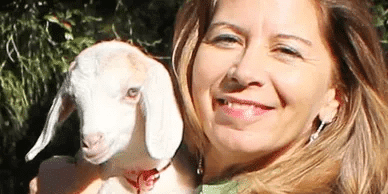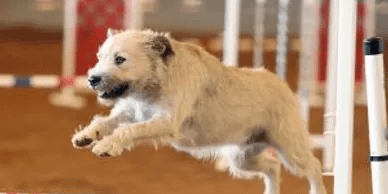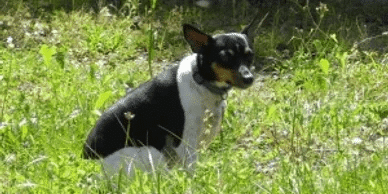Hear Them Speak

Hear Them Speak is the book I wish I'd had to read when I was first beginning to learn how to harness and control my animal communication abilities. When I finally realized that the often-upsetting experiences of being blindsided by an animal's projected emotions or pleas for help were happening because I was being a "psychic sponge," I started the search for courses and classes that would help me to access my abilities at will, and to turn down the volume when necessary. There weren't a lot of books on the subject of animal communication back then, and while those I found were very helpful in validating the fact that I was receiving telepathic information from animals, most were overviews of the subject with only a few pages of hands-on how-to material.
When I started teaching animal communication classes, many of my students asked me to create a textbook, something they could take home to remind them of what they'd learned in class and assist them as they continued to practice. Clients who were interested in learning animal communication but lived too far away to attend my classes asked for another way they could learn. With all these requests and my own memory of wanting more step-by-step direction percolating in my teacher-brain, I developed this twelve-week-course. Set up like a college-level course, it parses-out information and action steps in small, easy-to-digest pieces. But unlike a college textbook, Hear Them Speak is written in an engaging, conversational style with plenty of pictures and anecdotes from my experiences to help you understand the material.
You'll feel like your hand is being held every step of the way as you go from questioning to understanding, from playful practice (in which it's okay to be wrong) to serious study, from uncovering what's blocking you to blasting through those blocks. And once you start digging into the course material, you'll be invited to join an online study group of other people who have taken my classes or are working through the book. I'll be there to answer your questions, and so will my students who are now professional animal communicators themselves.
CLICK TO BUY HEAR THEM SPEAK NOWSome of the Animals You'll Meet
Jake Skellington
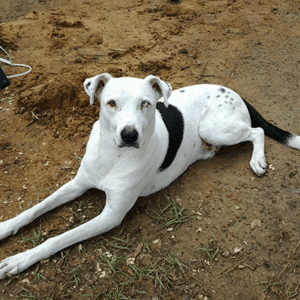
Jack was the benevolent leader of our pack for many years. He's on the other side of the rainbow bridge now, but when you learn animal communication, you'll learn that telepathy isn't bound by time or space or physical reality. Jack helps to teach us how to communicate with animals who are dealing with issues of mortality, and with animals who have already crossed the Rainbow Bridge.
Max the Gray Tabby
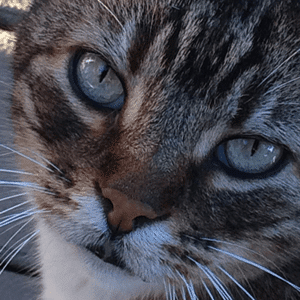
Max is our cat who is really (mostly) a dog inside. He teaches us about consciousness states. Many animals (and people) display a consciousness state that may not be congruent with their physical appearance. Max has the consciousness state of a big dog who won't hesitate to walk right up to another dog and command respect. Like Max, many animals might not be exactly what they seem, and most have a bigger mission in life than their people understand. Max loves teaching dogs how to be respectful of cats and to treat them as fellow beings worthy of love and respect.
Olivia the Octopus
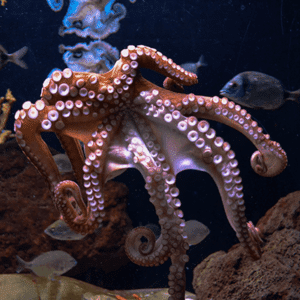
I've met cats who seem to be "not from around here," but Olivia the Octopus is the closes things to an alien life form that I've ever encountered. Is reincarnation a form of space travel across multiple universes and dimensions? I don't know, and I don't need to know. But I'm keeping an open mind. Olivia teaches us that there are many things in this world that we can't understand, and maybe we're not meant to. If we are open to new viewpoints and ideas, our understanding can evolve as we do, and the ability to change our minds about what's possible doesn't mean we were wrong before; it just means we have reached a new capacity for understanding.
Zuma the Lion
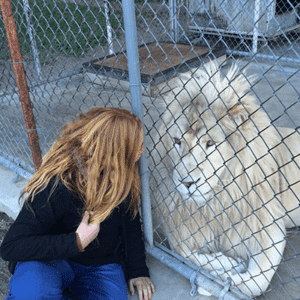
Zuma teaches us that it's easy to see when we're successfully communicating with an animal, just by looking at the expression on their face. Zuma also teaches us that animal communication is a useful tool to ensure that animals who live in captivity have everything they need to feel happy and secure. When I talked to Zuma, he wanted to things: to have his mane brushed by his keeper , and to have some hay to roll around in because he'd seen other animals getting hay and he wanted some too! The week after I communicated with Zuma, his caretakers sent me a video of him getting his mane brushed and then another of him rolling around in a pile of hay. Sometimes it takes so little to make animals happy. The ability to ask them what they want - and then hear their answer - is an immense gift, to us and to them.
The Goats (and Lambert the Sheep) of Dragonfly Pond Farm

The goat-and-sheep collective teach us (in a way I'll never forget) the perils and pitfalls of communicating with lost and missing animals. They teach us to trust ourselves and to at least ask "Hey, where are y'll? What happened?" Even when we're afraid of the answer we might receive. Because it's always better to know sooner rather than later. Trust me on this, because waiting until you feel stronger and can be more detached from the outcome isn't always the cleanest way forward.
Princess Grace

Princess Grace teaches us that when we ask better questions, we get the best answers. The book provides valuable tools - it's like a flashlight and a road map. But our animal companions and the animal friends all around us can be even more helpful - they're like taxi-drivers who know the roadways and can ferry us from point-A to point-B. The trick is, we have to know what to ask, when to dig deeper, and when to change direction. When I asked Princess Grace to give me some ideas for good questions, she reminded me of a stray cat named Spook who showed me what it feels like to purr. Princess Grace was exactly right! When we're learning to receive information based on how our animal friends feel physically, we should ask a cat we know to show us what it feels like to purr.
Read an Excerpt
Spook shows what it feels like to purr
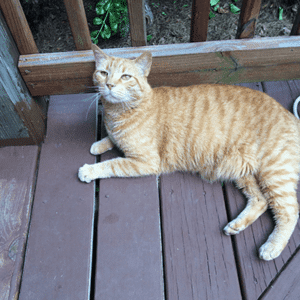
I have been owned by many cats throughout my life. Even after I started communicating professionally, it never occurred to me to ask a cat what it felt like to purr. Then, one day, a half-wild stray cat gave me that gift.
I think maybe he was the one to do it because it was surprise to him, too. He was a spooky little thing; we'd heard him meowing in the woods near the house for days before we saw him. I fed him far from the house so he would feel safe from humans, dogs, and other cats while eating. Every day, I moved his bowl of kibble a little closer to the house.
Finally, after about two weeks, we could see him, a three-month-old yellow tabby. We named him Spook, because he was a little ghost - or spy - lurking the perimeter, trying to be invisible. It took me several more weeks for me to lure him onto the porch so he could eat with the other cats. It took even longer before I could touch, and then pet him.
My morning routine - actually my routine most of the time - is fairly hectic. I'm usually running from one thing to the next the moment my feet hit the floor, because I know that by bedtime, I'll be rushing to fit one more thing from the long to-do list into my schedule.
I'll admit that except when I'm communicating, writing, or making art, I'm not always grounded. Scooping cat food into the bowls on the cats' feeding station is just one more click of the hamster wheel I'm on. I'll pause long enough to pet each of the cats who leap onto the table, but it's for their benefit, not mine.
On a particular day, I was rushing through my routine, scooping food into the line of bowls, plop,plop,plop, and giving a quick stroke on the back of each cat who leapt up onto the table to start eating.
When I stroked Spook, even while he was wolfing down his food (eating as if each meal might be his last) he arched his back and started purring. I felt an immediate sense of joy, serenity, and expansiveness open in my chest, a not-so-subtle vibration that felt like a ball of sunshine swirling outward, filling my heart chakra, then my whole body. It was an incredible feeling, a bit like an orgasm but centered in the heart.
Spook seemed as surprised by his sudden desire for human touch as I was. When I petted Spook on this day, he stopped eating, turned around, and presented his arched back for me to pet again, all the while purring like a Harley.
While I petted him, the feeling of sunlight-in-the-chest projected directly from his heart chakra into mine. It slowed me down, changing my focused determination into an expansive appreciation for that moment's joy.
Why and how your emotions can block communication

Worry, love, pity, frustration, anger, guilt, grief, fear: Any of these can block clear reception.
If you are worried that you will hear something upsetting, or even if you're just worried about your own problems, your mind may be churning on that worry. Even if you push the worry to the back of your mind, it can clog up your ability to receive clearly. It's like trying to concentrate on reading when the television is blaring in the next room. Your eyes are busy tracking the lines of print, but at some point you realize that you're not absorbing the information because your ears are tuned to the sound coming from the other room.
Even love can block clear communication, because when you are so in love with your animal companion, you may be unwilling - consciously or subconsciously - to take the chance of hearing that they are unhappy or need something you can't provide. And you can't just decide to block one subject without muddying up the rest.
Feeling pity for an animal can keep you from feeling anything but pity. There maybe a brave spirit inside that sad exterior, and if you're focused on appearances, you won't be able to connect deeply with the beautiful soul inside.
Frustration that you're not getting anything telepathically can keep you from getting anything telepathically! If you feel frustrated, check your body language. Are you leaning forwards, hands clenched, forehead furrowed, trying hard to understand what the animal has to say? If so, your frustration has led to TRYING instead of ALLOWING. When you're leaning forward, it is likely that you are reaching for answers, which can then lead to making stuff up. If you are attempting to communicate and getting nowhere, check your posture. Make sure you are leaning back, relaxed, making space in your heart and mind for the information to flow.
Anger coming from you or the animal can block clear communication. If you are angry at your cat for peeing outside the litter box, your anger will be all the cat sees, and he won't be eager to communicate his reasons or listen when you try to explain why you don't love that behavior. If two dogs are fighting, they won't be listening to any telepathic message you try to send because they are focused on their anger to the exclusion of all else.
Guilt and grief often go hand in hand. These emotions can not only block communication, they can color everything - every relationship, every decision, every experience - in a person or animal's life. These emotions can expand until they take up all the room in the heart and mind of the person or animal, preventing them from communicating clearly.
Wheeling and Dealing
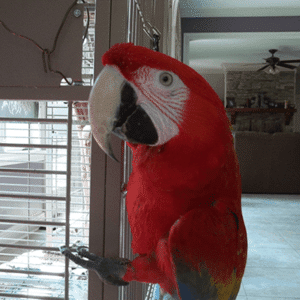
A big part of the professional animal communicator's job is counseling multi-species families and coming up with agreed-upon solutions that will work for everyone. When someone fails to hold up their end of the deal, that someone is usually (always) the human.
I have to admit, I have done it myself. When my Scarlet Mascaw, Talume, started projectile pooping outside his cage, I asked him nicely to stop. He declined. I asked why he was hell-bent on squirting streams of poop onto my clean-mopped floor.
His answer: "Why would I poop inside my cage? That's nasty!"
I had to concede Talume's point. I promised to clean his cage more often, but that wasn't a sweet-enough deal for him. He also wanted to be allowed more play time outside his cage. The deal we struck was that in return for not pooping inappropriately, he would get one hour of playtime outside his cage every day.
Parrots can be like toddlers; they will get into mischief if they're allowed outside their cages unsupervised. But I figured I could find the time to let him out while I cleaned the kitchen or folded laundry, so one hour of supervised playtime didn't seem like such a hardship.
Our agreement stuck for about a month. He got his hour of playtime and stopped projectile pooping. Then, I got busy and started backsliding on my end of the deal. He put up with that for about a week. Then he went back to projectile pooping across the room.
Even animal communicators can get busy and stop listening to their animal family members. And when no one's listening, animals have two very powerful tools at their disposal to get your attention. Pee and poop.
The underlying meaning in the way the message is conveyed is often pointedly direct. Inappropriate peeing is a very effective way to express the consciousness of being pissed-off. An animal peeing on your bed - or God forbid, you pillow - is even madder than the one who pees on your shoes. They've been trying to get your attention for a long time, and you haven't been listening. They're saying, "Maybe this will get your attention."
While the method of attention-getting is common, the reasons for such behavior are many and varied, anything from physical ailments like bladder infections to manipulative attempts to coerce humans to do better. Finding out what the animal is trying to relay through their misbehavior is, or course, where animal communication comes in.






